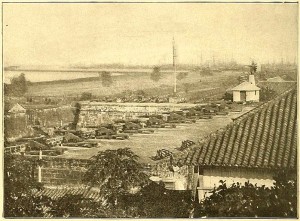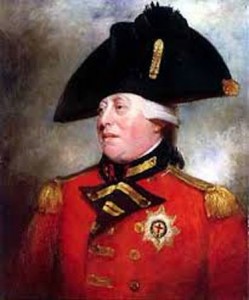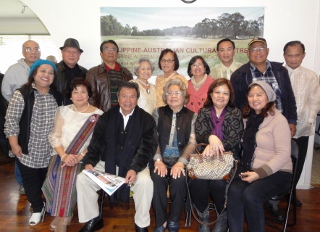

 When I wrote an article about the British Invasion of Manila in 1762, I purposely did not touch on a subject that is dear to me — early historical and cultural materials overseas. I am referring to the historical and art objects looted by the British invaders of Manila in 1762.
When I wrote an article about the British Invasion of Manila in 1762, I purposely did not touch on a subject that is dear to me — early historical and cultural materials overseas. I am referring to the historical and art objects looted by the British invaders of Manila in 1762.
I am always reminded by Jose Rizal’s knowledge of Filipiniana sources in London which attracted him to stay for almost a year from May 1888- March 1889 to undertake research works. He was introduced to the rich Filipiniana sources in London by Dr. Reinhold Rost who has a good library in his house. Dr. Rost was the director of the India Office Library in England.
In August 1888, Rizal was admitted as a reader at the British Museum. The purpose of his desire to spend time at the museum was to read and copy a rare volume of Antonio Morga’s Sucesos de las Islas Filipinas available at the British Museum. Rizal considered Morga’s Sucesos… as the best Spanish written history on the Philippines. It was published in Mexico in 1609.
It was Dr. Rost, an authority on Malayan languages and customs who recommended Rizal to have access to the British Museum. For almost two months, Rizal copied by long hand the whole book and used historical sources for his annotation of the book. But before I continue and discuss the 40 hours pillage and looting of jewels, gold and silver coins, art treasures, and other precious articles from churches, monasteries, colleges and some of rich families in Manila, let me dwell briefly on the events immediately prior to the British invasion of Manila.
The Seven Years’ War took place between 1754 and 1764 (250 ago years this year), involving most of the great powers of the time and greatly affected Europe, North America, Central America, the West African coast, India and the Philippines. In a nutshell the main cause was the fight for colonies that led to antagonism between the great powers of Europe.
In particular, Great Britain competed with France and Spain over trade and colonies.
Succeeding events showed changes in the alliances and many had switched partners with Prussia establishing an alliance with Britain while France joined Austria. Anglo-Prussian alliance was joined by smaller German states, like Hanover, and later Portugal join the picture. The Austro-French alliance included Sweden, Saxony and later Spain. All these irritants ended with the signing of the Treaty of Paris between France, Spain and Great Britain and the Treaty of Huberstusburg between Saxony, Austria and Prussia, both in 1763.
But, just before the end of the Seven Years’ War, on 4 January 1762, England declared war on her traditional enemy, Spain. King George III decided to go into war with Spain looking at a ‘great advantages of his trading subjects in those parts and would the same time give a very sensible blow to the commerce of Spain.’ On January 19, 1762, the East India Company, a British trading company founded in 1600 for the purpose of trading in Asian countries and in-charge of British possessions overseas, decided to support the decision to invade Manila.
On 21 January King George III released his war instructions to Brigadier General William Draper, commander of the British land forces. Succeeding separate war instructions were made to Rear Admiral Charles Steevens, Commander in Chief of the British Fleet in the East Indies and Rear-Admiral Samuel Cornish, Commander of the British sea forces to prepare the British attack of Manila which would come from Madras, India where the East India Company was already mobilising its naval and military forces, with prior instruction from the British monarch.
On September 22, 1762, the Spanish authorities in Manila were caught unaware by the arrival in Manila Bay of a British fleet jointly commanded by Admiral Cornish and General Draper. The following day, the two British officers officially informed the Spanish colonial government in Manila that they have orders from their King to take possession of the Philippines and demanded the immediate surrender of the Spanish forces. By then the British invaders occupied the churches of Malate, Ermita, San Juan de Bagumbayan, and Santiago and all the houses in the area.
On 24 September 1762, the British demand for the surrender of Manila was rejected. The British troops attacked and bombarded the Walled City. From the bastion of San Diego and San Andres, Spanish guns retaliate throughout the day but without success. In its effort to fight the foreign invaders, the Spanish colonial government mobilised archers from Pampanga, Bulacan and Laguna against the British invaders but to no avail.
SURPRISE ATTACK
A week later, then acting Governor Archbishop Manuel Antonio Rojo commanded a surprise attack with 500 Filipinos and a number of Spanish residents on the British occupied area. Before the chaos, Simon de Anda y Salazar was appointed lieutenant governor and captain-general by Archbishop Rojo in his capacity as acting governor and captain-general of the Philippines. Anda and his followers left Manila and established its capital in Bacolor, Pampanga and proclaimed himself governor.
At dawn of October 3, Filipinos led by Manalastas, a Pampango leader, rush out, invaded and assaulted the British trenches in Manila, killing around 200 British soldiers in a hand-to-hand combat that followed. However, on 4 October 1762, the British invaders smashed all Spanish and Filipino oppositions within and outside the Walled City.
As a result, Archbishop Rojo surrendered Manila to the British invaders in order to end the slaughter of soldiers and civilians. Two days later, Manila capitulated with the British conquerors demanding payment of P4M indemnity from the Spanish government and the surrender of fortified areas in Manila, Cavite and other places. The terms of Manila’s surrender to the British on October 7, included a guarantee that properties of residents would be protected; Catholic religion would be preserved, provided no attempt to convert any of Protestant subjects to the Catholic faith; liberty for people living in the countryside and freedom of movement; protection of liberty of commerce for city residents, and others.
Before the arrival of designated British Governor of Manila, General Downsonne Drake on 10 October, the 40 hours pillage and looting of the walled city had taken place. Writing in his journal, Archbishop-Governor Rojo described the events and said: ‘The city was given over the pillage, which was cruel and lasted for forty hours, without excepting the churches, the archbishopric, and a part of the palace.
‘Although the captain-general objected at the end of the twenty-four hours, the pillage really continued, in spite of the orders of the British general for it to cease. He himself killed with his own hands a soldier he found transgressing his orders, and had three hanged.’
As mentioned earlier, one of the terms agreed in the capitulation of Manila was the payment of P4M as ransom for the preservation of the city and its inhabitants from pillage. Archbishop Royo only paid P542,425 and the remaining balance of P3,457,574, a promissory note payable by the royal treasury in Madrid. After the war, when the British government demanded payment for the unpaid balance, the Spanish Crown refused to pay. One of the reasons presented by the Spanish Ambassador in England included the violation of the agreement by General Draper allowing his troops to rape and plunder the fallen city, among others. In justifying its refusal to pay, the Spanish side pointed out that the ‘British invaders actually obtained more than 4 million pesos, considering the several million pesos worth of precious jewels, art treasures, silver wares, etc, looted by them from the churches, monasteries, colleges and homes of rich families, not to mention the P542,425 which Archbishop paid General Draper.’
Going back to the point of pillage and looting in the city which the Spanish side used to refuse payment, Draper in hisdefence against the Spanish accusation, vehemently denied wrong doing, including the accusation that he ‘ordered, or permitted, the city to be sacked and pillages for forty hours together, by four thousand English [soldiers and officers], who plundered Manila of more than a million of dollars.’ In his official denial, General Draper said: ‘We entered Manila by storm on the 8th of October 1762, with a handful of troops, whose total amounted to little more than two thousand, a motley composition of seamen, soldiers, sepoys, cafres, lascars, topasees, French and German deserters.
‘Many of the houses had been abandoned by the frightened inhabitants, and were burst open by the violence of shot, or explosion of shells. Some of these were entered and pillaged. But all the military men know, how difficult it is to restrain the impetuosity of troops in the first fury of an assault, especially when composed of such a variety and confusion of people, who differed as much in sentiments and language, as in dress and complexion.’
General Draper, however, admitted that some wrong doing were committed by the invaders and said: ‘… several robberies were committed, after the capitulation was signed, is not to be denied; for avarice, want, and rapacity, are ever insatiable. But that the place was pillaged for forty hours and the pillage authorised and permitted by me, is a most false and infamous assertion. General Draper even cited a military order that he issued to the invading forces on 5 October which reads, in part: ‘The utmost order and regularity to be observed.
All persons guilty of robberies, or plundering the churches and houses, will be hanged without mercy. The guards to send frequent patrols both day and night, to prevent all disorders. The drummers to beat to arms, to officers to assemble with their men, and call the rolls. The adjutants to go round the town, take an exact account for the safeguards, posted for the protection of the convents, churches, and houses.’
Another military order he issued on 7 October said: ‘All the inhabitants of Manila are to be looked upon and treated as His Britannic Majesty’s Subjects. They having agreed to pay four millions of dollars, for the ransom and preservation of their city and effects. The criminals executed for robbery and sacrilege to be buried at sunset.’
Draper also stated that a strict search was made on board the squadron by the Admiral’s orders, and among the troops, to recover what had been stolen and secreted; and all the money, plate and jewels, so recovered, were put into the treasury and allowed, and accepted as part of the ransom.
Whoever was telling the truth, Archbishop Rojo on the part of the Spanish crown or General Draper on the side of the British monarch, Filipino historian Gregorio F. Zaide undertook a research on the looted items and he said: ‘It should be noted that all of the jewels, gold and silver coins, art treasures, and other precious articles looted by the British troops (officers as well as soldiers) were recovered by Draper. He recovered, as he admitted only 26,623 pesos. The Spanish authorities and the city residents, who were all victims of British vandalism claimed that more than one million pesos (excluding jewels, art treasures, and valuable family heirlooms) were stolen from them.
What happened to the rest of the loot? The Spanish claim that the loot in cash reached more than one million pesos seemed credible, considering that Manila then was one of the richest cities in Asia. Evidently, the British officers were also participants in the looting spree. For instance, General Draper brought to London some Spanish flags and eight copper plates which printed the celebrated Murillo Velarde Map of 1743. He donated the Spanish flags to his alma mater, Cambridge University. The copper-plates were used for some time to print copies of the Murillo Velardo Map which were sold to public libraries and cartographic collectors. One such copy was purchased by the Library of Congress, Washington, D.C.
‘Eventually, these copper-plates came into the possession of the British Admiralty which later melted them and used them to print its own charts. It maybe said that Admiral Cornish acquired a share of the loot because he died a rich bachelor in 1816; his wealth inherited by his only nephew, Samuel Pitchford, a captain in the British Royal Navy.
‘Worse was the case of Dawsonne Drake, a member of the Madras Council of the East India Company, who became the British governor of Manila. Upon his return to Madras at war’s end, he was tried by the Madras Council on various charges, including disobedience, mismanagement of Company funds, accepting bribe from the Chinese, and violent quarrels with other military and civil officers. He was found guilty on some of the charges, he was demoted in rank and condemned to live permanently in Madras. Disgraced, he died in 1781, but a wealthy man. After his death, his property was inventoried by a committee which found some priceless Spanish oil paintings which he looted from the palace of the Spanish governor in Manila. Many rare Spanish maps and charts, which were part of the Manila loot, can be seen today in the British Museum and the British Admiralty at London.’
The richness of the Filipiniana collection of the British Museum has been acknowledged by many historians and researchers. Even Rizal, as early as 1888, 125 years after the ‘pillage and looting’ of Manila by the British invaders, realised how rich the collection of the British museum. In writing to Mariano Ponce in July of 1888, Rizal said: ‘I am dedicating myself night and day to certain studies… about our country, its history, its administration; … the very rich collection of the British Museum, a collection which cannot be found anywhere else, is serving my purpose. For this reason, I will stay here [London] for a long time.’ Rizal spent almost two years in London undertaking historical studies using published rare Philippine history books written during the couple of hundred years of Spanish colonisation of the Philippines.










Leave a Reply